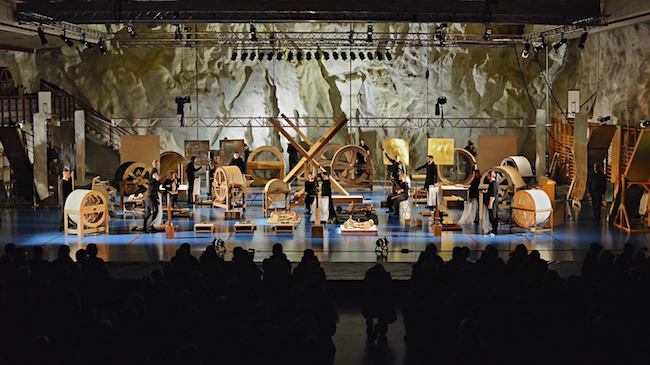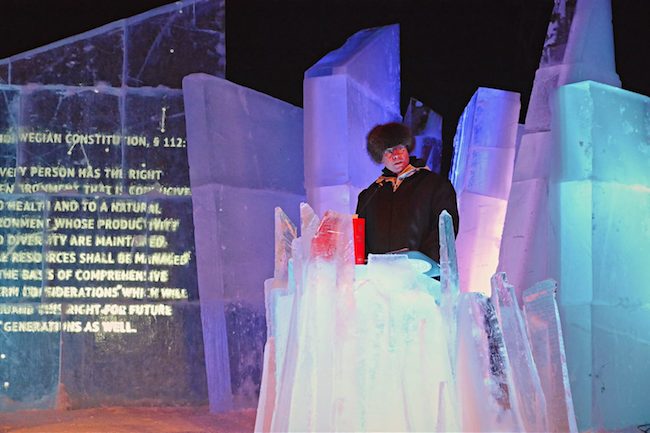
When Culture Asks Questions
Insight: Barents Spektakel 2017 in Kirkenes
11/02/2017
A Norwegian city with some Russian additions
Have you heard of the town of Kirkenes, in the far northeastern part of Norway, above the Arctic Circle? It’s quite a distance away from any European metropolises for one to think about it much; located in the Barents Sea region, Kirkenes is 5102 km from Rome, 4012 km from Vienna, 3881 km from Berlin, and 1930 km from Riga. In terms of size, it takes up only 2.15 square kilometers of a peninsula, and its name translates to “church (kirke-) down at the cape (-nes)”.
I can easily spot the town’s perimeter from my airplane window. After a long flight from Oslo that featured a view of a mostly monochrome “dessert” of snow, the plane suddenly veers in order to approach the tiny landing strip of Kirkenes – from above it looks like a ruler lying in the middle of nowhere. On the way from the airport to the center of town we see signs showing the way to Murmansk. Although just 200 km away, Murmansk lies in a different time zone, and during the winter season, there’s a two-hour time difference between the two cities. Many of the signs in Kirkenes are in two languages, Norwegian and Russian. Kirkenes is next to the Russian border, and up to 1826 it was actually part of a joint Norwegian/Swedish-Russian district. There are ethnic Russians still living here, and Russian citizens also like to come and visit; similarly, the people of Kirkenes pop over to Murmansk when they get the urge for a change of scenery.

Kirkenes. Photo from Pikene på Broen
In effect the center of the Barents Sea region, Kirkenes’ main business is iron mining and its sea port – the latter being the end destination of the legendary Bergen-Kirkenes-Bergen Norwegian coastal cruise operated by the Hurtigruten shipping operator (and on which the parents of American film actress, René Zellweger, met). Another cinema factoid: last year this usually peaceful town experienced a few adrenalin-filled hours as illegal drag races took place on its streets – cars with masterful drivers behind the wheel careened through the snowy streets of Kirkenes...for the filming of the Norwegian action film Børning 2. On a normal day, however, the only speeding around that takes place here is done by people swooshing about town on their charmingly Scandinavian kicksleds. Snowmobiles are also popular, of course.
What’s in the air?
The festival as a barometer of topical issues
Another happening that spices up life in Kirkenes is the Barents Spektakel festival. For the last thirteen years it has stirred the salty air of the town with an interdisciplinary program that features the visual arts, music, and performances. Under the artistic direction of Luba Kuzovnikova, the curatorial group Pikene på Broen comes up with a central theme for the festival’s program that links all of the events together. With this year’s slogan “The Industrial Boomerang”, the Barents Spektakel focuses on the new wave of industrialisation emerging throughout the arctic borderlands.
At the start of last year, the international media was covering the story of how Norway had decided to “thaw” it’s economic relationship with Russia, with which it shares a 196-km-long border. Economic and trade processes are being revived, and both countries have agreed to sustain a continuing dialog about studies concerning potential petroleum and gas reserves on either side of the border. However, certain challenges have arisen as well – at the beginning of February, Norway accused Russia of cyber attacks; Russia has recently denied Norwegian politicians entry into the country; and in last year’s concert program at Kirkenes’ church, the Pussy Riot song “Punk Prayer” – as performed by Norwegian musician Pål Moddi – was cut from the list…
But how do these events affect the daily lives of people living in these borderlands? Do they change anything in people’s personal relationships? Do they change anything in the natural environment, the landscape...the cultural scene? These are question that the festival aims to address, with the ultimate goal of strengthening the dialog between both countries through cultural cooperation and exchange.

Photo: Mikhail Slavin
A soundscape in the quiet capsule of a bomb shelter
Peter Aidu and The Music Laboratory (Russia). “Sound Landscapes”
On the festival’s program for this year’s opening concert: a soundscape performance. It was held in Kirkenes’ Fjellhallen (which literally means “hall in the mountain”), a former bomb shelter built in the heart of a mountain, but which now serves as a school sports gymnasium. Last winter the space took on a new purpose as it became a temporary shelter for Syrian refugees who had crossed into Norway from Russia, on bicycles, in -20º C weather conditions.
But now, during the festival, composer Peter Aidu and the artists of The Music Laboratory treated their audience to an unbelievable symphonic experience titled “Sound Landscapes”. In 2016 the production was awarded the prestigious “Golden Mask” theater festival award.
“Sound Landscapes” is an audio-visual experience in two dimensions of experience: close your eyes and bring to life your sensory memories of a rainy day, when, on the roof and window sills of your country cottage, the rain plays a composition that starts off with a prelude of warning winds, culminates with roaring banging, and ends with an epilogue bringing a message of peace… Experience the sharp gales of a snow storm shaking the walls… The peak hour of work in a metalworking factory… Experience an aerial bombing… Go to places you’ve always wanted to go, and to places you hope you never have to go.

Photo: Mikhail Slavin
Open your eyes, and you see in front of you a surreal stage-set on which, in perfect synchronization, artists work mechanical sound equipment, rustle sheets of paper or polyethylene, crack whips, turn windmills, vibrate, drum, thunder, and make sound freeze and stop.

Photo from Pikene på Broen
The ice region’s future will be decided in an ice courtroom
Morten Traavik (concept), and Peter Istad (ice architecture), Norway. “The Тrial of the Century”
When the ice on the nearby lake had reached an approximate thickness of half-a-meter in mid-January, 190 tons of it was cut out over two days – for the construction of an improvised courtroom. Because it is lake ice, it is not exactly crystal clear; much like amber, it has seaweed, rocks, and other detritus trapped in it, as well as cracks and bubbles. It is, in all respects, a living and organic encapsulated world.

Preparation work. Photo from Pikene på Broen
The surreal courtroom was constructed over several days in the center of Kirkenes so that on the second day of the festival, a three-day-long theatrical court case could be played out. Festival-goers sat in the spectator seats made of ice and became the witnesses to a hearing in which the Norwegian environmental protection organizations Greenpeace and Nature and Youth petitioned that the Norwegian government was commencing a search for petroleum reserves in the Barents Sea. Essentially, it was a way in which these people, who are most affected by any and all activities taking place in the Barents Sea, could voice their opinions before the real hearings take place later this year, in Oslo.
.jpg)
Opening Night of the Barents Spektakel 2017. Photo: Bernt Nilsen
Dance with the slumbering
BANDALOOP (California), FROST (Norway)
A gigantic crane has been standing in the KIMEK shipyard since the 1990s, which is when it was brought over from Belgium. The crane slumbers, having been unused since it was erected – it turned out that the ground on which the crane was built is not geologically stable, and so it cannot be used to lift loads. Subsequently, it has become a sort of sculptural landmark of the city’s skyline, one which the people of Kirkenes have become accustomed to and don’t give much notice of. Over all these years, the only marginally practical purpose that it has served is as a weather vane – the crane’s arm turns along with the direction of the wind.
.jpg)
BANDALOOP (California), FROST (Norway). Photo: Bernt Nilsen
On the festival’s opening night, the pioneering vertical dance troupe BANDALOOP, from California, “reactivated” the crane. Accompanied by sound and light effects created by the electronic duo Frost, the humongous industrial object transformed into a 50-meter-high vertical “dance floor” for the choreography of BANDALOOP.
Old Seaman’s Club. Photo:
A drink or two at the old mariners’ tavern
Sever7 (Russia)
Much like the crane, the Old Seaman’s Club has been out of commission for quite a while, and is basically just waiting to receive the order to be torn down. Also like the crane, the Club is an icon of the city, and its revival during the festival is a way to get the city’s inhabitants to look at it in a new light. The artist group Sever7 has slightly altered the scenery of the nostalgic locale so that during the festival, it has become a place for festival-goers and participants to relax and meet up.

Part of the installation “Borderlines” by Morten Traavik, displayed during the Barents Spektakel festival in Kirkenes in 2011. Photo: Marius Hauge
In other years, the festival’s spotlight has been aimed at the Norwegian-Russian border. In 2011, the artist Morten Traavik “moved” the border posts and signs to the pedestrian street in the center of Kirkenes. This act allowed people to interact with the border, which normally is not a thing to toy around with. So, in only for a brief moment, one could simply jump from one country to the other, and back again.
---
In a sense, the “Sound Landscapes” symphony-in-four-parts I have described above traces the history of Kirkenes. Heading home after the concert (or any other event in the festival’s program), as the snow crunches underfoot (which is also the only sound heard at night here), one can see how the 3500 inhabitants of Kirkenes peacefully live their lives behind the bright windows of their simple (and very Nordic) two-story wooden houses. These buildings were built not too long ago – they have no real history to them. After having hundreds of bombs dropped on it during the German occupation, the city had to be literally rebuilt from ruins.
As the festival’s organizers themselves say – where the artists come from, and whether or not they have a physical connection to the region, is not of primary concern when deciding on which artists to put in the program. What is important is that their presentations have tangible references to the context of the region.
